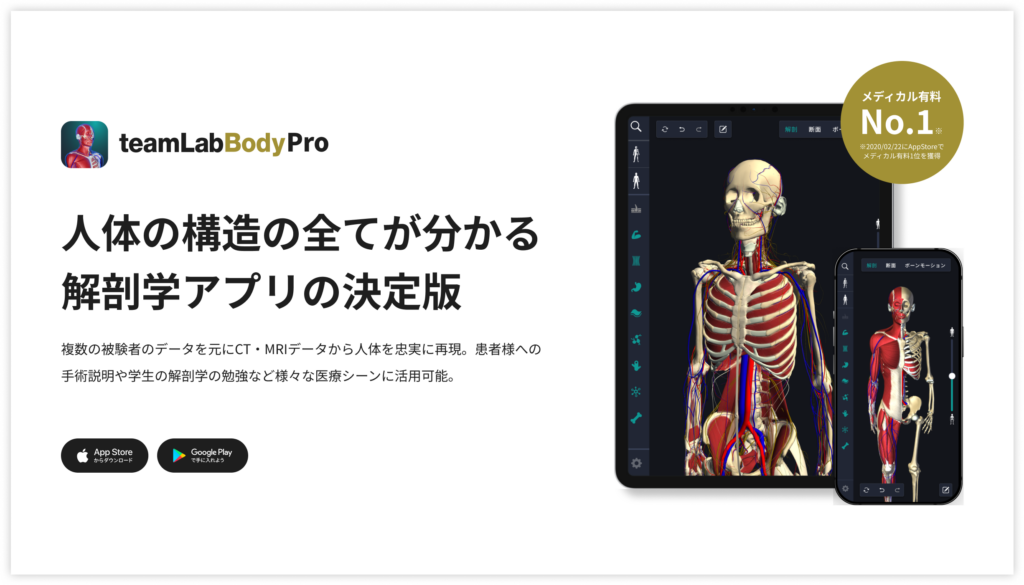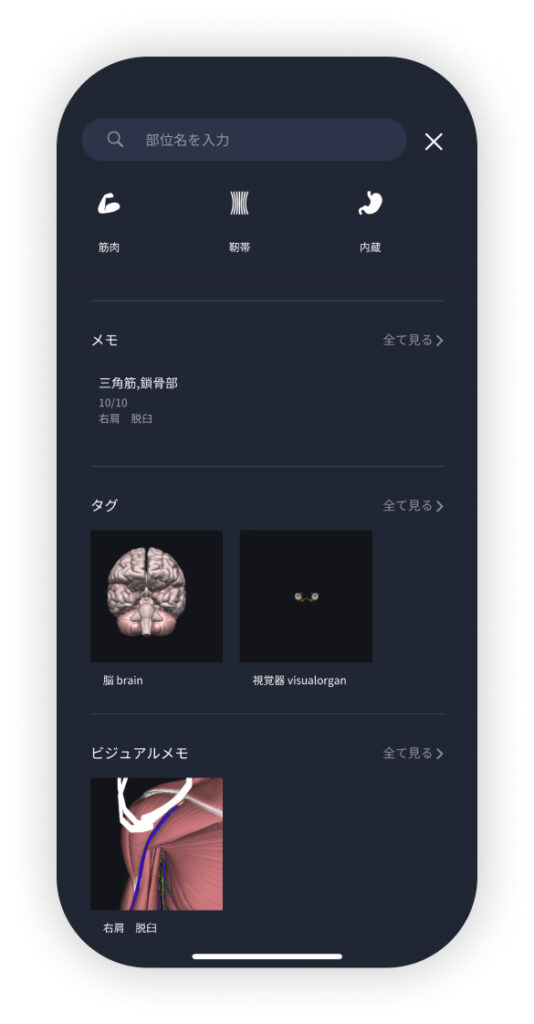beginning
In this article, I will explain effective study methods, starting with knowledge of specialized parts in human anatomy.
In human anatomy, it is necessary not only to memorize the names of various organs, muscles, and bones, but also to remember where they are located in the body. Therefore, it is necessary to learn as efficiently as possible.
I hope you will deepen your understanding even a little by reading this article and using the app.
Now, I will explain the contents of “anterior longitudinal ligament and posterior longitudinal ligament” and how to study human anatomy.
teamLab Body Pro Free Download
A 3D anatomy app that shows all the structures of the human body
Download teamLab Body Pro here!

What are anterior longitudinal ligament and posterior longitudinal ligament?
The anatomy application allows you to view a selection of anatomy 3D models. In this model, there are various observation methods such as surfaces, cross-sections, and nervous systems. This time, I'll explain using an anatomy application.
About anterior longitudinal ligament

The anterior longitudinal ligament is a strong ligament that runs longitudinally at the front of the vertebral body, and exists continuously from the occipital base to the front of the sacrum. This ligament attaches to the front of the vertebral body and the front of the intervertebral disc,An important stable structure to prevent overstretching (excessive warping) of the spineThat's it.
In particular, in areas with high mobility, such as the lumbar spine, a lot of tension is applied when the trunk is bent backwards. Also, due to aging or stress, this ligament ossifies and may develop into conditions such as anterior longitudinal ligament ossification (OPLL).
The anterior longitudinal ligament is not just a support structure, but it is an element that is deeply involved in controlling spinal movement and understanding disorders, so it is important to understand the connection between form, position, and clinical practice.
About posterior longitudinal ligament

The posterior longitudinal ligament is a ligament located on the back surface of the vertebral body — that is, between the vertebral body and spinal cord, and runs longitudinal through the spinal canal from the occipital bone to the sacrum.
It has an opposite positional relationship with the anterior longitudinal ligament,The role of suppressing hyperflexion (bending forward too much) of the spineIt is responsible for The posterior longitudinal ligament is also firmly attached to the central part of the intervertebral disc, especiallyUnderstanding the pathogenesis of a herniated discIt is an essential structure for
This is because when a hernia protrudes backwards (in the direction of the spinal cord), it first hits this ligament. Also, “posterior longitudinal ligament ossification (OPLL),” where this ligament ossifies due to aging or pathological changes, also causes serious movement impairment due to nerve compression.
Study points
Anatomical understanding: a vertical band continuous with the vertebral body
Since the anterior longitudinal ligament runs longitudinal through the entire spine in a form that closely follows the front of the vertebral body, firstThe structure of the vertebral body and what to learn as a setIt's basic. Understanding differences in ligament thickness and movement between cervical, thoracic, and lumbar vertebrae will lead to understanding the pathology. Use a 3D app for learning, and while observing the entire spine from the front, you can visually understand where and how it sticks. Also, the connection between intervertebral discs and ligaments is also a key point.
Functional understanding: Braking and maintaining posture during hyperextension
The primary role of the anterior longitudinal ligament is to suppress hyperextension of the spine. You can experience that your ligaments are stretched by bending your trunk backwards and checking the feeling that your lower back and front of your neck feel tight. Also, the anterior longitudinal ligament is not only a static support,Maintaining a standing positionIt is also involved in, and is always in a state of mild tension. Understanding what kind of structure works to maintain posture is deepened by capturing it as a coordinated movement of muscles, bones, and ligaments.
Practical application: relationship with ossification and trauma
Clinically, there are cases where anterior longitudinal ligament ossification (OPLL) is a problem. In particular, ossification in the cervical spine causes spinal cord compression and may lead to limb numbness and muscle weakness. Also, in “hyperextension injuries” caused by traffic accidents or falls in elderly people, anterior longitudinal ligament ruptures and injuries may also be related to spinal cord injury, so evaluation is important. Understanding normal structures is essential so that they can be used in CT and MRI imaging and clinical judgment in orthopedic surgery.
How to study human anatomy
I will explain specific study methods using human anatomy applications.
Check your past learning history and practice repeatedly
Here are the steps to check your anatomy learning history and practice iteratively effectively.
1. Check your learning history in the app
Reviewing your learning history with the application is an important step in effectively advancing anatomy learning. First, launch the app and go to the learning history section from the main menu. Many anatomy apps are designed to show your progress in the form of graphs and lists, so you can visually check which parts you've learned about and how much time you've spent.
By using this data, you can understand which areas you have strengths in and where you need to spend more time and effort. We also recommend using a dedicated tag or notebook function to mark areas you are particularly weak at or where you need to relearn. Regularly checking your learning history and looking back on past learning content will lead to efficient review and deepening understanding.
2.Make a plan for iterative learning
Making an efficient repetitive learning plan based on learning history is extremely effective in promoting knowledge retention. First, identify weak points and areas where you need to relearn. Next, arrange these study items into a weekly or monthly calendar and create a specific study schedule. By proceeding in a planned manner, you can learn each part evenly and avoid packing in a large amount of information at once.
Using a task management app or digital calendar to set study reminders is effective. Also, it's important to have the flexibility to regularly review progress and revise plans as needed. By having goals and proceeding with your studies in a planned manner, you can efficiently acquire anatomical knowledge.
3.Use 3D features to learn visually
By utilizing the 3D function, learning anatomy is easier to understand visually. The 3D model shows the structure of the human body three-dimensionally, and each part can be observed in detail. This makes it possible to intuitively grasp positional relationships between deep muscles and organs that are difficult to capture in a planar view. For example, you can learn even the smallest details by rotating specific muscles and bones and zooming in and out.
Also, there are many apps that have the function of displaying cross-sectional views of each part using a 3D model, which is useful for deepening understanding of internal structures. This diversity of visual information helps with memory retention and improves immediate responsiveness in tests and practice situations. By utilizing the 3D function and learning visually, you can learn anatomy knowledge more deeply and efficiently.
Use the memo function concretely

Make notes so you don't forget the things and points you've noticed while studying. The memo function can be used for different purposes, such as inputting text, saving images, and writing memos. Tag your notes to make them easier to review later.
Test your learning regularly in the form of quizzes
Regularly testing what you've learned in a quiz format is a very effective way to anchor your anatomy knowledge. Quiz-style tests help you objectively grasp your level of understanding and areas you lack while repeating knowledge.
For example, by using a learning app to conduct quizzes every specific period, you can reconfirm what you've learned and strengthen your memory. There are a wide range of quiz formats, such as multiple choice questions, fill-in-the-blank questions, and short answer questions, and each helps understanding from a different angle and develops the ability to utilize various types of knowledge.
Get feedback
If possible, get feedback from other learners and experts. It helps you find your own gaps in understanding and areas for improvement. You can also keep yourself motivated to learn by regularly testing yourself. Feeling a sense of accomplishment and progress increases motivation for continuous learning.
summary
This time, I explained how to study “anterior longitudinal ligament and posterior longitudinal ligament” using an application!
Thank you for reading this far.
I would be happy if reading this article helped you learn about anatomy.
Learning is a long, never-ending journey, but I sincerely wish you all the best. Let's continue to study together and work hard for the national exam!
Please look forward to the next blog.
teamLab Body Pro Free Download
A 3D anatomy app that shows all the structures of the human body
Download teamLab Body Pro here!





